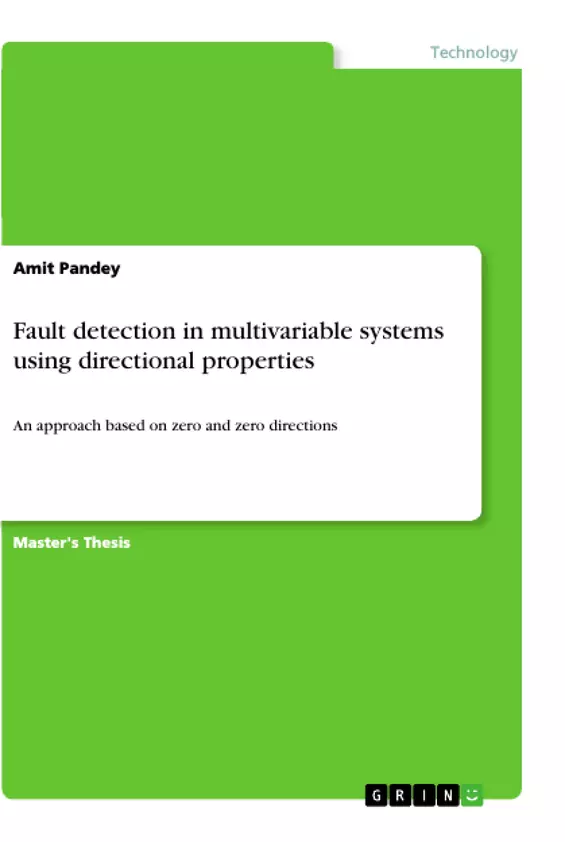The paper formulated a novel algorithm for making the combination of outputs in the output zero direction of the plant always equal to zero. Using this algorithm and the result of MacFarlane and Karcanias, a fault detection scheme was proposed which utilizes the directional property of the multivariable linear system. The fault detection scheme is applicable to linear multivariable systems. Results were obtained for both continuous and discrete linear multivariable systems. The results were further verified by the steady state analysis of the plant.
Recently fault detection and isolation of non-linear system have generated a lot of interest. The present paper deals with only linear systems there is scope of extending this work to the non-linear systems. There is a possibility of using the properties of non-linear zeros to detect and isolate faults present in a non-linear plant.
Inhaltsverzeichnis (Table of Contents)
- CHAPTER I INTRODUCTION
- 1.1 Terminology
- 1.2 Types of Faults
- 1.3 Approaches to the Fault Detection and Diagnosis
- 1.4 Brief Description of Previous Work
- 1.5 Motivation for the Present Work
- CHAPTER II ZEROING OF OUTPUTS IN OUTPUT-ZERO DIRECTIONS
- 2.1 Introduction
- 2.2 Definitions, Problem Setup and Assumptions
- 2.3 Main Result
- CHAPTER III USE OF OUTPUT ZEROING THEOREM FOR FAULT DETECTION
- 3.1 Novel Fault Detection Scheme Using Multivariable Zeros and Zero-Directions
- 3.2 An Illustrative Example
- 3.3 Steady State Analysis
- CHAPTER IV FURTHER RESULTS FOR FAULT DETECTION USING ZERO AND ZERO DIRECTIONS
- 4.1 Extension to Multiple Faulty Rows and Columns
- 4.2 Extension of Theorem 2.1 and Theorem 2.2 to the Non-Proper Systems
- 4.3 Main Result
- 4.4 Tests for Diagnosing Faults in A and C Matrices
- CHAPTER V ZEROING OF OUTPUTS OF DISCRETE TIME SYSTEMS IN THE OUTPUT ZERO DIRECTIONS
- 5.1 Definitions, Problem Setup and Assumptions
- 5.2 Main Result
- CHAPTER VI USE OF OUTPUT ZEROING THEOREM FOR DISCRETE TIME SYSTEM FOR FAULT DETECTION
- 6.1 Novel Fault Detection Scheme for Discrete Time Systems
- 6.2 An Illustrative Example
- 6.3 Steady State Analysis
- 6.4 Extension of Fault Detection Results to System with Multiple Faulty Rows and Columns
- 6.5 Tests for Diagnosing Faults in A and C Matrices
- CHAPTER VII SUMMARY AND FUTURE WORK
Zielsetzung und Themenschwerpunkte (Objectives and Key Themes)
This thesis proposes a novel algorithm for fault detection in multivariable linear systems using directional properties. The research aims to develop a robust and efficient method for identifying faults in complex systems, focusing on the zeroing of outputs in specific directions. This approach offers a unique perspective on fault detection, drawing on the strengths of multivariable system theory and directional analysis.
- Fault detection in multivariable linear systems
- Zeroing of outputs in output-zero directions
- Application of directional properties in fault detection
- Development of a novel algorithm for fault detection
- Analysis of continuous and discrete time systems
Zusammenfassung der Kapitel (Chapter Summaries)
Chapter I introduces the concept of fault detection and diagnosis in multivariable systems, providing a foundation for the work presented in the thesis. It outlines various types of faults, approaches to fault detection, and a review of previous work in the field.
Chapter II introduces a key concept – the zeroing of outputs in output-zero directions. It defines the problem setup, assumptions, and presents the main result of the research. This chapter lays the theoretical groundwork for the proposed fault detection scheme.
Chapter III demonstrates the application of the output zeroing theorem for fault detection. A novel fault detection scheme is proposed, incorporating multivariable zeros and zero-directions. The chapter presents an illustrative example and explores the steady-state analysis of the system.
Chapter IV extends the results of the previous chapters to handle more complex scenarios, including systems with multiple faulty rows and columns. It examines the application of the output zeroing theorem to non-proper systems and presents the main result of this extension.
Chapter V focuses on extending the fault detection scheme to discrete-time systems, a crucial step in expanding the applicability of the proposed method. It defines the problem setup for discrete-time systems and presents the main result.
Chapter VI further explores the use of the output zeroing theorem for fault detection in discrete-time systems. A novel fault detection scheme for discrete-time systems is proposed, and its application is illustrated with an example. The chapter also examines the steady-state analysis and extends the results to handle multiple faulty rows and columns.
Schlüsselwörter (Keywords)
The primary keywords for this work are: multivariable systems, fault detection, directional properties, output-zero directions, zeroing of outputs, linear systems, continuous systems, discrete-time systems, steady-state analysis.
- Quote paper
- Amit Pandey (Author), 2004, Fault detection in multivariable systems using directional properties, Munich, GRIN Verlag, https://www.grin.com/document/519976



